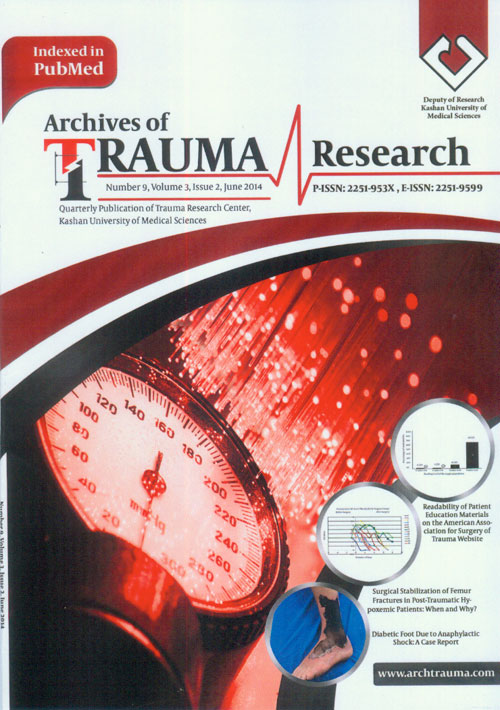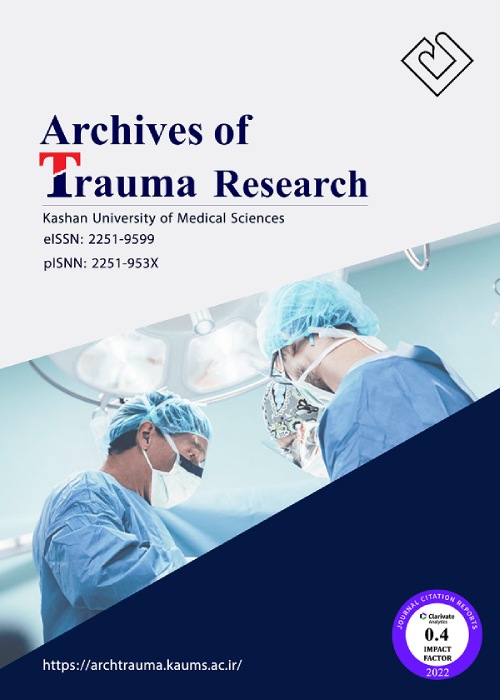فهرست مطالب

Archives of Trauma Research
Volume:3 Issue: 2, Apr-May 2014
- تاریخ انتشار: 1393/04/01
- تعداد عناوین: 10
-
-
Page 1
-
Readability of Patient Education Materials on the American Association for Surgery of Trauma WebsitePage 3BackgroundBecause the quality of information on the Internet is of dubious worth، many patients seek out reliable expert sources. As per the American Medical Association (AMA) and the National Institutes of Health (NIH) recommendations، readability of patient education materials should not exceed a sixth-grade reading level. The average reading skill of U. S. adults is at the eighth-grade level.ObjectivesThis study evaluates whether a recognized source of expert content، the American Association for Surgery of Trauma (AAST) website’s patient education materials، recommended readability guidelines for medical information.Materials And MethodsUsing the well-validated Flesch-Kincaid formula to analyze grade level readability، we evaluated the readability of all 16 of the publicly-accessible entries within the patient education section of the AAST website..ResultsThe mean readability of all articles was grade level 10. 9±1. 8. All of the articles had a readability score above the sixth-grade level except one article. The readability of the articles exceeded this level by an average of 4. 9 grade levels (95% CI: 4. 0-5. 8; P < 0. 0001). Only one of the articles had a readability score below the eighth-grade level، the average reading skill level of the United States adults. The readability of the articles exceeded this level by an average of 2. 9 grade levels (95% CI: 2. 0-3. 8; P < 0. 0001)..ConclusionsThe AAST’s online patient education materials may be of limited utility to many patients، as the readability of the information exceeds the average reading skill level of adults in the U. S. Lack of patient comprehension represents a discrepancy that is not in accordance with the goals of the AAST’s objectives for its patient education efforts..Keywords: Patient Education as Topic, Electronic Health Records, Comprehension
-
Page 7BackgroundIn recent decades, the incidence of spinal cord injuries has increased. In a systemic review on epidemiology of traumatic spinal cord injury in developing countries reported 25.5/million cases per year..ObjectivesTo assess the quality of life (QOL) among the veterans of Iran-Iraq war with chronic spinal cord injuries (SCI) and to evaluate long-term impressions of SCI on their quality of life..Patients andMethodsFifty-two veterans, all male, with chronic spinal cord injury from Iran-Iraq war (1980-1988) were interviewed and examined. The mean age of veterans at the time of interview was 49.3 years (38 to 80 years). Veterans were assessed by using a 36-item short-form (SF-36), hospital anxiety and depression scale (HADS) and the Barthel index. The presence or absence of pressure sores and spasticity were documented as well..ResultsThe mean age of veterans at the time of study was 49.3 years. Pearson''s correlation test showed that depression and anxiety have a reverse association with mental component summary (MCS) scale and physical component summary (PCS) scale scores, respectively. Regression analysis showed a negative effect of depression and pressure sore on PCS. Moreover, no association was found between the duration of injury and age with quality of life..ConclusionsLower QOL was found among veterans with chronic SCI. More researches on health-related quality of life (HRQOL) are needed to give us a better understanding of changes in life of patients with SCI and the ways to improve them..Keywords: Quality of Life, Spinal Cord Injury, Veteran, Iran
-
Page 13BackgroundPatients, who survived from shotgun injuries, often have some retained lead pellets in their bodies. Several cases of lead toxicity have been reported regarding these patients..ObjectivesThis study seeks to compare the serum lead level in patients who have retained lead pellets in their bodies with the control group..Patients andMethodsIn this case-control study, we gathered the serum lead levels of 25 patients with some retained lead pellets in their bodies due to shotgun and 25 volunteers without similar lead exposure and compared them in view of the age, gender, and living place..ResultsWhile the mean serum lead level in both groups was lower than the standard level (i.e. 40 µg/dL), the mean ± SD of serum lead level was 29 ± 12.8 µg/dL and 25.3 ± 6.4 µg/dL in the case and control group, respectively without any significant difference (P = 0. 30). However, a positive relationship was seen between serum lead level, and the number of retained lead pellets (r = 0.447, P = 0. 025). .ConclusionsAlthough extensive surgery to remove the lead pellets is not recommended in patients injured with shotguns, those with many retained lead pellets in their bodies should be considered at risk for lead poisoning and monitored carefully..Keywords: Serum, Toxicity, Shotguns
-
Page 17BackgroundMetallo-beta-lactamase (MBL) producing Pseudomonas aeruginosa in the burn patients is a leading cause of morbidity and mortality and remains a serious health concern among the clinicians..ObjectivesThe aim of this study was to detect MBL-producing P. aeruginosa in burn patients and determine multidrug-resistant (MDR) strains, and respective resistance patterns..Patients andMethodsIn this cross-sectional study, 270 strains of P. aeruginosa were isolated from the burn patients referred to Ghotbeddin Burn Hospital, Shiraz, Iran. Among them, 55 MBL-producing P. aeruginosa strains were isolated from 55 patients hospitalized in burn unit. Minimum inhibitory concentrations (MICs) and MBLs were determined by the E-test method..ResultsOf the 55 burn cases, 29 (53%) were females and 26 (47%) males. Injured burn patients’ ages ranged from 16 to 87 years, with maximum number of cases in the age group of 16 to 36 years (n, 40; 72.7%). Overall, 32 cases were accidental (60%), and 22 were suicidal burns (40%). Of the 55 burn patients, 17 cases were expired (30%). All deaths were due to chemical exposures. In antibiotic susceptibility testing by E-test method, ceftazidime was the most effective one and 35 isolates (63.5%) were resistant to all the 11 tested antibiotics..ConclusionsRoutine microbiological surveillance and careful in vitro testing of antibiotics prior to prescription and strict adherence to hospital antibiotic policy may help to prevent, treat, and control MDR and pandrug-resistant (PDR) P. aeruginosa strains in burn units..Keywords: Burn patients, Pseudomonas aeruginosa, Metallo, Beta, Lactamase, Drug Resistance
-
Page 22BackgroundRespiration management is an important and critical issue in prehospital transportation phase of multiple trauma patients. However, the quality of this important care has not been assessed in Iran Emergency Medical Services’ (EMS)..ObjectivesThis study was conducted to investigate the quality of prehospital respiration management in patients with multiple trauma, referred to the Shahid Beheshti Trauma Center, Kashan, Iran..Patients andMethodsThis cross-sectional study was conducted in the first six months of 2013. All the 400 patients with multiple trauma, transferred by EMS to the Shahid Beheshti Medical Center, were recruited. The study instrument was a checklist, which was completed through observation. Descriptive statistics were presented..ResultsOut of all included individuals, 301 were males (75.2%) and 99 were females (24.8%). The most common mechanism of trauma was traffic accident (87.25%). Furthermore, 71.7% of patients were injured in head and neck and chest areas. The quality of consciousness monitoring and airway management was desirable in 95% of cases. However, the quality of monitoring patients’ respiration was only desirable in 42% of cases. Only 18.6% of patients received oxygen therapy during prehospital transportation..ConclusionsThe quality of monitoring patients’ respiration and oxygen therapy was undesirable in most patients with multiple trauma. Therefore, the EMS workers should be retrained to apply proper respiration management in patients with multiple trauma..Keywords: Quality of Health Care, Respiration, Prehospital Emergency Care, Multiple Trauma, Accident
-
Page 28BackgroundPost-traumatic hypoxemia can deteriorate during operative manipulations..ObjectivesIn the present study, criteria-based approach was applied to determine optimum conditions for femur surgery. The aim of this study was to optimize perioperative management of post-traumatic hypoxemia..Patients andMethodsIn this prospective observational study, posttraumatic adults with PaO2 < 70 mmHg in room air were enrolled. Physiological parameters, O2 saturation (SO2), arterial blood gas (ABG) analysis, Schonfeld fat embolism index score (SS), and Murray’s lung injury scores (LIS) were assessed. The management protocol was femur surgery when patient was hemodynamically stable with LIS < 2.5 and PaO2/FiO2 > 200 mmHg (FiO2 < 0.5, PEEP < 8 cm H2O)..ResultsA total of 31 adults (26 males and 5 females) with LIS of 0.1 to 2.5 (26 patients) and > 2.5 (five patients) at admission were recruited. Sixteen patients were admitted within 24 hours and 15 between 24 and 90 hours after injury. Thirteen patients were operated within 24 hours. Post-operative LIS was improved. No adverse sequels or mortality were seen..ConclusionsAppropriate surgical stabilization can be safely performed during established post-traumatic hypoxemia using a multidisciplinary approach, continuous monitoring, and serial investigations to diagnose fulminant pathology and associated injuries..Keywords: Post, traumatic hypoxemia, Damage, control surgery
-
Page 33Introduction
Diabetic foot is a clinical disorder, which is commonly seen in patients with diabetes mellitus. It is also the major cause of below knee amputation in the world. There are many underlying causes such as neuropathic, ischemic, and infectious causes for diabetic foot. Local or systemic complications may develop after snake bite..
Case PresentationWe reported a very rare case, involving a 78-year-old male admitted to the Emergency Department, who developed anaphylactic shock and diabetic foot after the snake bite..
ConclusionsReviewing the literature, this is the second reported case of snake bite associated with diabetic foot..
Keywords: Snake Bite, Anaphylactic Shock, Diabetic Foot


